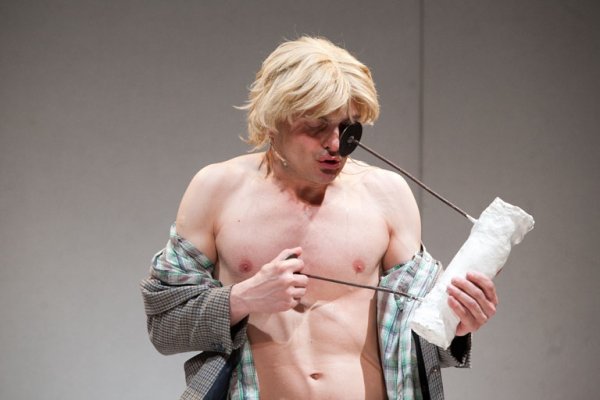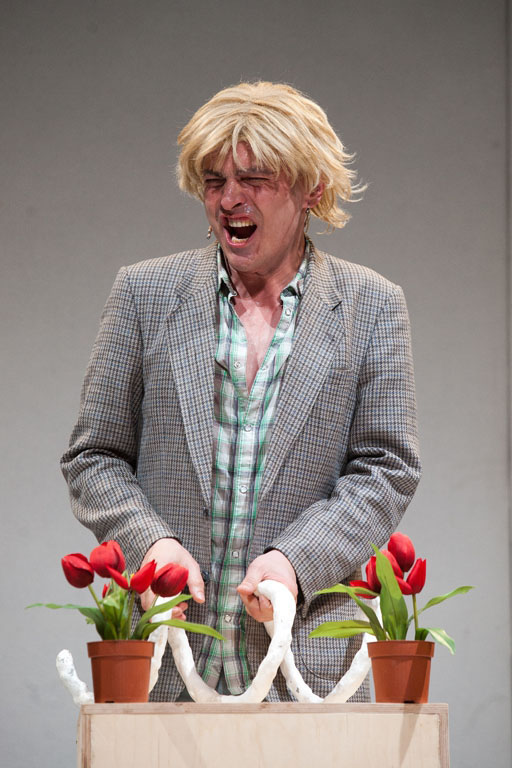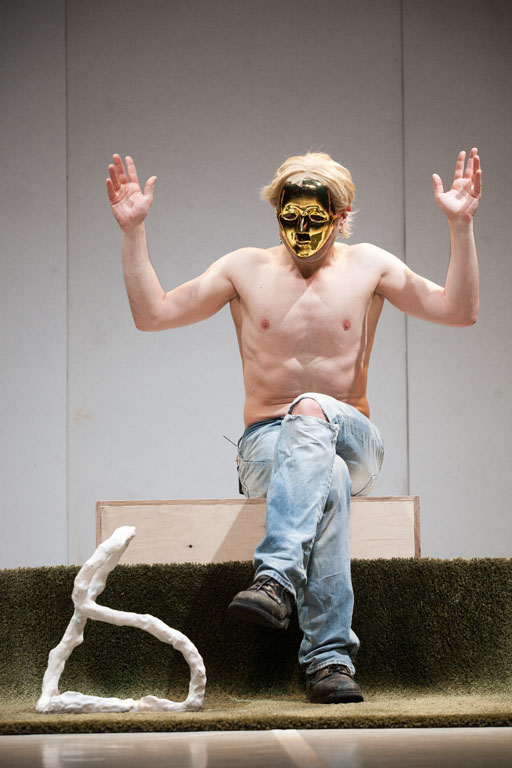Ivo Dimchev's recent solo creation I-ON, an investigation of Franz West's sculptures named Adaptives is a prelude to a group creation (X-ON) that will have its premiere in Brussels this autumn. At the very first sight, I-ON is the staging of a meeting between a body and a series of objects, a dynamic chain of intense encounters between the performer and West's artworks.
Obviously, this meeting cannot be reduced only to a connection between a body and some objects (and try to see what comes out of it), for the simple reason that the body in itself and the lifeless objects / the inert matter are nonsense.
I already knew that I was going to be confronted with the presence of a performative body (as I found myself from the very beginning in a theatrical convention, as watcher, as spectator, as witness to the above-mentioned meeting). Besides, I already knew that the objects brought on stage are artworks. Therefore, what I saw was a meeting between the performative intentionality of the artist and the artistic information that the Adaptives have already brought with them and Franz West imprinted on the matter they are made of...
The investigation pursued by Ivo Dimchev can be read in various ways; due to the nature of the performance that deals with artworks already made, there is a great temptation to start with an aesthetic approach. There would be equally important to choose a phenomenological reading, as the performance offers the possibility of directing the view to the way in which certain kinds of objects and ways of existing onstage are crossed and turned into the shape of a new modality of being shown. In addition, the examples could easily go on...
But, first of all, let's give the floor to Franz West: "An art dealer once told me: a sculpture must stand on its own! (...) I used to make Adaptives without pedestals, to be simply laid on the ground or leaned against something. And then he wrote me something about the dignity of the pedestal, an interesting aspect." (Franz West).
This is what can be read in a Conversation between Franz West and Kasper Konig (1992). Aesthetically speaking, the pedestal directs the eyes of the watcher to the work of art and shows the sculpture in a doubled forceful light. Especially in the galleries, the pedestal is that instrument provided with the dignity of growing the silent discourse of the work of art.
In Ivo Dimchev's performance, the pedestal is a key-piece and its dignity consists in being more than an aesthetic instrument, going into the sphere of an ontological generator. The pedestal is on the stage from the very beginning and a blond wig can be seen on it. It announces thus the possibility of the human presence onstage and also the absence of the work of art, as the pedestal is, by its nature, the very ground of the exposed artistic creations.
Most of the process within the performance is directly connected with the function of the pedestal, but it also goes beyond it: the meeting between the performative body and the Adaptives is centered on or organized around the pedestal. It is not exactly the centre of a certain world, but it is the core of the meeting between two worlds: the one that belongs to the performative body and the one of the Adaptives. Therefore, the meeting is set on a stronger light and this is what I would call the ontological function of the pedestal: it brings an added degree of being to a context born out of the strange encounter between two different substances (the body and the object).
Their synthesis is elaborated with the help of the focusing presence of the pedestal, which will not remain on the centre of the stage until a certain moment of the performance. It is taken out when the last Adaptive is brought onstage and I-on's identity is revealed or, better said, verbalized. That was the very point where I started to sense the beginning of X-on, the horizon to which what I have just witnessed would be headed to.
Taking out of the picture the very centre around which the meeting between the body and the objects was accomplished looks like a logical motto to what is to come.
At emotional level, the performance has a dynamics of intensity, which results from the direct meeting between the body and the objects or from the moments of separation between them. There could be even drawn a map from those points where the emotional intensity increases or decreases, depending on the stages of the process of synthesis. The mentioned emotion is the result of the artistic act, what it is potentially caused in audience (I am speaking now from the position of the spectator that experienced that).
For instance, the moment when the performer sings My Funny Valentine, kneeled away from the pedestal (which is supported by an Adaptive) conveys a strong emotion, due to the tension between the lively presence of the performer and the silent self-containing of the object. The distance between the body and the object and the absence of a contact point increase the dramatic status of the meeting.
In contrast, the moment when the performer sings with his hands strongly clasping the spiraled Adaptive reveals the tragic touch of the synthesis. At this point, I fully got to feel the pleasure of being trapped in the field of the unknown owing to tension of being unaware of the indefinable nature of the synthesis resulted from the meeting between the performative body and the Adaptives.
These were only two examples. On the structure of the performance, the moments result in the perception of emotional degrees of encounter, which outlines the difference in substance between the two worlds and the beauty of the struggle to surpass the separation.
The investigation of the Adaptives turns thus into a dynamic birth of points of meeting and points of estrangement that alternatively unite and separate the natures of the body and the objects.
The artistic means used in the performance (the performer's voice, the lights or the sound effect) cannot be read in themselves. They are co-substantial with the concept that traces the line, which break or bring together the two worlds, within their meeting.
As it was already mentioned, this performance invites to many levels of interpretation, it would have been interesting maybe to exploit the phenomenological potential of the piece. Phenomenology somehow states that all I have is what I see, against traditional views that stipulated a certain essence behind things or beings, like a principle molding them. Phenomenologically speaking, I should watch what I see in the very light it appears in front of me... It would be a useful investigation for those interested in philosophy to regard the perfomative body and the artworks in their synthesis as a new phenomenon perceived in a certain light. (I understand here phenomenon in its etymological sense, like something which is present in the light, namely something that we can see in itself....)
Another view would be that from the perspective of the politics of the body. The images and patterns exposed in the performance (from Hamlet's monologue to the drinking from a Coca Cola can or to the suggestion of an anthropomorphic God integrated in the fashionist system of this age ) threw light for sure on my inner clichées and launch questions aiming at my own private relation, as an embodied social being, with the objects around me.
Usually, there is mostly instrumental interaction with objects in daily life. The shift from instrumentality to an unknown and indefinable type of relation with objects operated by Dimchev, points at a new politics of the body in which the body, as social entity could reconsider the nature of instrumentality...
Overall, the interpretations and the unfolding of the perspectives on the performance can go on and on...
The body seems to turn into an adaptive sometimes, in order to throw on the adaptive itself a condition of change... The object, even informed with an artistic message previous to its entering the stage, remains silent and self-contained...The human presence is wandering, revolted, seducing, violent, reasonable, mad, sometimes intensively absent....
I see Magritte's painting in a flash of my mind, while watching : ceci n'est pas une pipe...
I no longer see a body, I couldn't perceive an adaptive... Ceci n'est pas un adaptive... The essence of the meeting, with its search and message keeps on hiding something... What I see is no longer an adaptive... and no longer a certain body... What is it? What happens when the body meets the object?
I may choose to find meanings, to search for perspectives... Or I just have the possibility to sit there, watch and try to think and feel what happens in itself, what lies beyond all the significances and associations that cross my mind. Obviously, my subjectivity blocks he possibility of sensing what is going on in itself and the honest thing to do is to mirror the meeting that I witness into my own self...
I start to feel like an adaptive, like a created object, already informed with messages, functions, possibilities... (with the significant difference that I am aware of this condition of mine... Therefore, it becomes clear that what I see is a meeting in which the synthesis is operated by the constant awareness of the performer in relation with the silent world and self contained meanings of the adaptives)
When the body of the performer meets the object, after the sequence of meeting points between two substances on stage, as a spectator, I choose turn into an aware breathing adaptive. By this, I mean that a lesson that I can learn out of this performance is that, after experiencing the meeting with a performative act, I should try to switch my functions (from the social ones to the personal ones), just the way the objects unfolds unexhaustable possibilities when it meets the world of the performer...
Paradoxical peak of emotion...
Photo source: http://festival.exodos.si/


